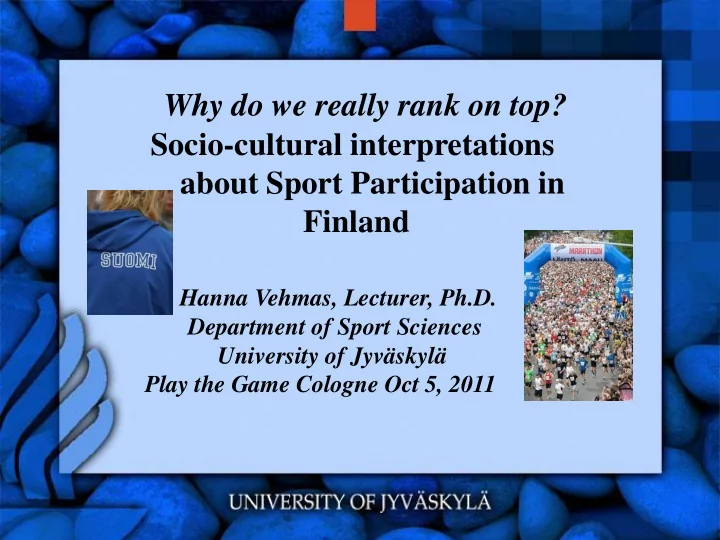

Why do we really rank on top? Socio-cultural interpretations about Sport Participation in Finland Hanna Vehmas, Lecturer, Ph.D. Department of Sport Sciences University of Jyväskylä Play the Game Cologne Oct 5, 2011
Background there are clear differences in sport participation within European countries studies generally indicate that (with some exceptions) the further south and east we go in Europe the less popular the sport participation Finland often on the top of these “rankings” Why? http://ec.europa.eu/public_opinion/archives/ebs/ebs_334 _en.pdf National Sport Surveys (since 1994/ 2001-2002) at www.slu.fi
According to National Sport Survey 2009-2010: Finns are generally active in sport and physical activities: • 90 % of Finns participate in sport at least twice a week, 55 % at least 4 times a week • 16 % of Finns (536 000) participate in volunteer sport activities and spend 10 hrs./month in volunteer sport activities • 92 % of the Finnish children and youth participate in sport and physical activities
According to National Sport Survey 2009-2010: Most popular physical activities: walking, bicycling, cross country skiing, swimming, gym, running, Nordic walking 44 % of Finns´ participation (women 49 %, men 40 %) meets health recommendations
Need for deeper analyses In order to 1) understand more precisely the role and significance of sport in a certain society, and 2) in order to use comparative data for sport participation and wellbeing promotion purposes of citizens , a more in-depth evaluation needs to be made of the elements of sporting habitus
Why do people participate in sport and physical activities? Application of Bourdieu to formulation of Sporting Habitus Structure Function SPORTING HABITUS Meaning Actor
1) Structural determinants for sport participation general level of welfare number of sports facilities participation correlations with demographic abd socio-economic backgrounds gender equality school sport
2) Function of sport in society Nordic model of welfare and a strong public sector sport as part of welfare society tool for national identity tool for health promotion strong volunteer sport sector ( ca. 9 000 sport clubs) sport clubs emphasizing the (amateur) right to sport
3) Individual motives and reasons for sport participation casual vs. serious leisure leisure profit making? community spirit health promotion and counteracting aging subjective vs. objective activity
4) Cultural meanings and definitions of sport increasing role of leisure on people’s life style and identity formation protestant work ethics and doer sentiment enhancing active leisure? obedience of social norms from gardening to marathons – how do we define and perceive sport and other physical activities? utilitarian sports nature relationship
Conclusions Finland is a case of contradiction in physical activity participation: a sportive nation with a lot of (health related) symptoms of inactive life style How is this possible?
Thank you! hanna.m.vehmas@jyu.fi
Recommend
More recommend